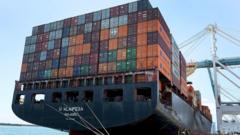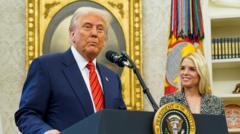The WTO has revised its global trade forecasts, predicting a decrease due to US tariffs, particularly affecting North America, while highlighting potential trade growth in Asia and Europe.**
WTO Warns of Decline in Global Trade Amid US Tariff Policies**

WTO Warns of Decline in Global Trade Amid US Tariff Policies**
The World Trade Organization predicts a significant fall in global trade due to the tariffs imposed by President Trump, raising concerns over future economic uncertainty.**
The World Trade Organization (WTO) has issued a stark warning regarding the impending contraction of global trade owing to the tariff policies initiated by US President Donald Trump. According to the WTO's latest report, the world trade volume is projected to decline this year amid fears of reciprocal tariffs and political instability, complicating trade dynamics further.
The organization emphasizes that North America could witness a particularly steep drop in trade, estimated at over 10% in the region. Ngozi Ikonjo Iweala, director general of the WTO, expressed profound concern over the "decoupling" of the US and China, suggesting a troubling new normal in international trade relations.
Originally, the WTO had anticipated a 2.7% expansion in global goods trade by 2025; however, it has now revised its expectations to a 0.2% decrease. Ralph Ossa, the chief economist at the WTO, pointed out that tariffs act as significant policy levers with numerous, often unintended, repercussions. He noted that trade policy uncertainty could severely hinder trade flows, adversely affecting exports and overall economic activity.
Effective April 5, the US enforced a baseline 10% tariff on most foreign imports, while specific countries and products gained exemptions. In contrast, Chinese tariffs have surged much higher, averaging around 145% on varieties of goods. The reaction in the US stock market was immediate, with major indexes opening lower due to prevailing uncertainty.
Despite the anticipated downturn in trade involving the US, the WTO indicated that regions such as Asia and Europe are still expected to experience modest growth in exports and imports this year. The report noted that the overall contributions from other regions would remain favorable towards world trade stability.
In a noteworthy first, the WTO's report also includes projections concerning services trade, which pertains to the exchange of services rather than goods. Industries like tourism and finance fall under this category, and the WTO forecasts a 4% growth in services trade by 2025 — a decrease of approximately one percentage point from earlier expectations.
Throughout his presidency, Trump has rolled out a series of fluctuating tariff announcements, claiming that these taxes will incentivize American consumers to favor domestically produced goods, thereby driving investment and increasing tax revenues. Critics, however, argue that reviving US manufacturing poses complexities that may take decades to resolve, with immediate economic ramifications likely to hinder progress.
Recently, Trump adjusted his aggressive tariff strategy, announcing a 90-day suspension on levies against numerous trading partners while maintaining them against China, in response to rising political and market pressure. Economists, including the governor of the Bank of England, have warned that Trump's tariff policy could diminish disposable income for British consumers.
In light of these developments, the global trade landscape remains precarious, with the potential for both growth and decline as countries navigate the challenging economic terrain shaped by ongoing tariff negotiations.




















